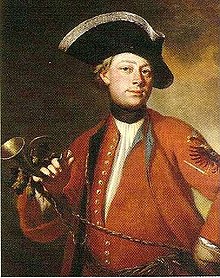Anselm Franz, 2nd Prince of Thurn and Taxis
| Anselm Franz | |||||
|---|---|---|---|---|---|
| Prince of Thurn and Taxis | |||||
 |
|||||
| Prince of Thurn and Taxis | |||||
| Period | 21 February 1714 – 8 November 1739 | ||||
| Predecessor | Eugen Alexander Franz | ||||
| Successor | Alexander Ferdinand | ||||
| Born |
30 January 1681 (date of baptism) Brussels, Spanish Netherlands (place of baptism) |
||||
| Died | 8 November 1739 (aged 58) Brussels, Austrian Netherlands |
||||
| Spouse | Maria Ludovika Anna Franziska, Princess of Lobkowicz | ||||
| Issue |
Alexander Ferdinand, 3rd Prince of Thurn and Taxis Princess Maria Philippine Eleonore Maria Augusta, Duchess of Württemberg Prince Christian Adam Egon |
||||
|
|||||
| House | Thurn and Taxis | ||||
| Father | Eugen Alexander Franz, 1st Prince of Thurn and Taxis | ||||
| Mother | Princess Anna Adelheid of Fürstenberg-Heiligenberg | ||||
| Religion | Roman Catholic | ||||
| Full name | |
|---|---|
| German: Anselm Franz |
|
Styles of Anselm Franz, Prince of Thurn and Taxis |
|
|---|---|
 |
|
| Reference style | His Serene Highness |
| Spoken style | Your Serene Highness |
| Alternative style | Sir |
Anselm Franz, 2nd Prince of Thurn and Taxis, full German name: Anselm Franz Fürst von Thurn und Taxis (30 January 1681, Brussels, Spanish Netherlands – 8 November 1739, Brussels, Austrian Netherlands) was the second Prince of Thurn and Taxis, Postmaster General of the Imperial Reichspost, and Head of the House of Thurn and Taxis from 21 February 1714 until his death on 8 November 1739.
Anselm Franz was the eldest child and son of Eugen Alexander Franz, 1st Prince of Thurn and Taxis and his wife Princess Anna Adelheid of Fürstenberg-Heiligenberg. The date of his birth is unknown, but Anselm Franz was baptised on 30 January 1681 at the Our Blessed Lady of Zavel Church in Brussels.
Under his father, at the beginning of the War of the Spanish Succession the administration of the Imperial Reichspost was moved from Brussels to Frankfurt am Main. When his father died, Anselm Franz was appointed Postmaster General by Charles VI in 1715, and returned to the family's home in Brussels, but the city now had no significance for the Reichspost. He therefore moved back to Frankfurt am Main in 1724, where he bought a plot of land on which he later started construction of the Baroque Palais Thurn und Taxis in 1729. In 1725, he was able to lease the postal system of the Austrian Netherlands as a Habsburg fief. His move to Frankfurt was drawn out over several years, as the city council had some objections and in any case the construction of his palace took its time. From 1737 he lived in the still unfinished palace in Frankfurt, but then returned in 1739 to Brussels, where he died unexpectedly.
...
Wikipedia
